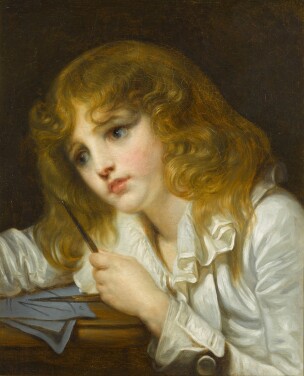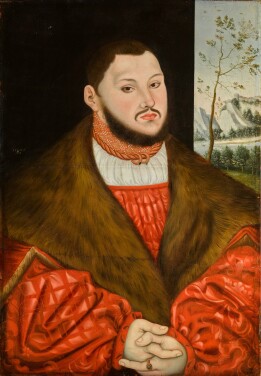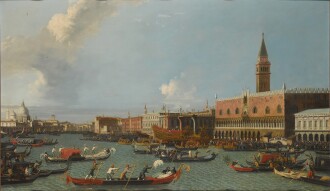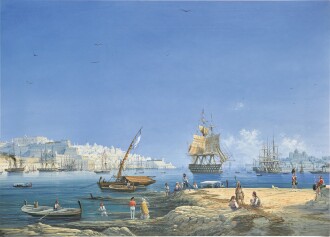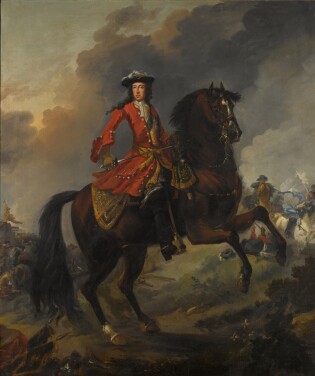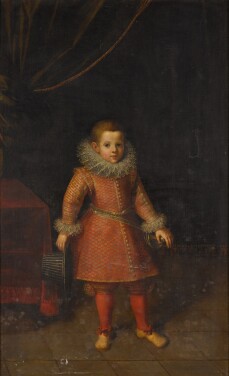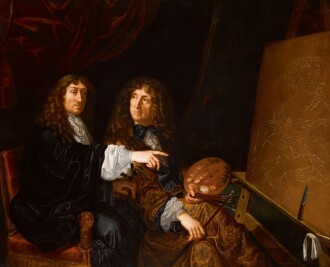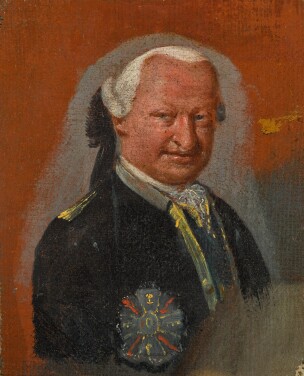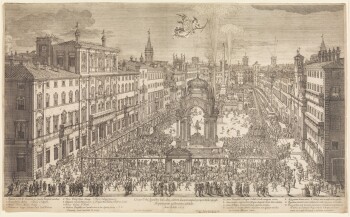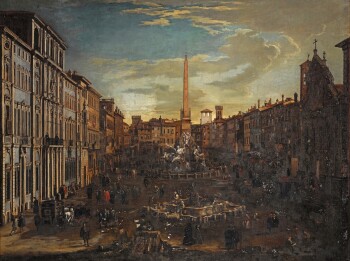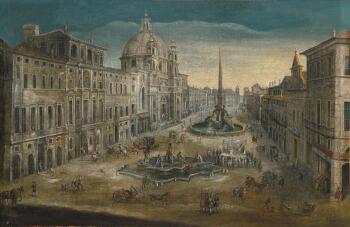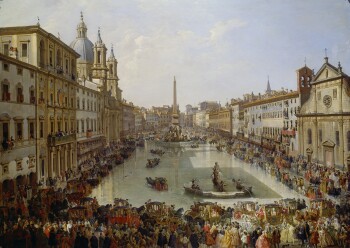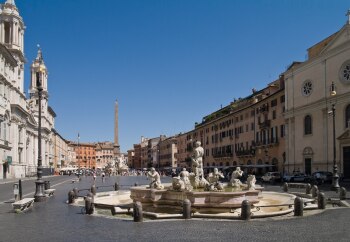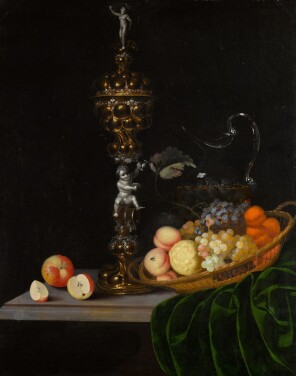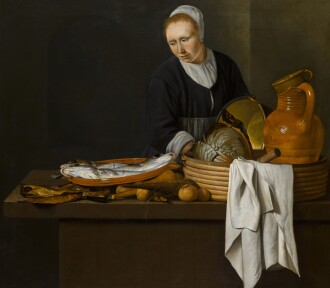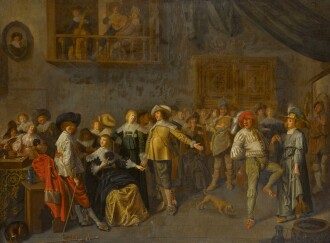T his winter’s Old Master Paintings Day Sale offers examples from all the major schools of Western European painting, from gold grounds of the early Italian Renaissance, to fine examples of German Renaissance paintings, through the Italian and Spanish Baroque and the Dutch Golden Age, to elegant 18th-century views, portraits and still lifes. The Day Sale will be on view in our galleries from 2-4 December, in the lead-up to bidding closing online on Saturday 5 December and will feature lots with estimates ranging from less than £5,000 to £150,000. We are delighted to present a rich and varied selection of works that will appeal both to seasoned collectors and buyers new to Old Master Paintings.
Featured Highlights
Rare Portraits Rediscovered
This pair of full-length portraits formerly carried an anonymous attribution to the 17th-century Nuremberg School. Now the discovery of a signature has confirmed them as the finest painted works, and two of only six known extant portraits, by the artist Michael Herr (1591-1661), known today principally through drawings and prints. The portraits were painted in celebration of the sitters’ marriage – click on each detail to learn more about them.

Thanks to a print that also depicts this sitter, the identity of this man may be confirmed as Johann Jobst Schmidtmaier von Schwarzenbruck (1611-47). Schmidtmaier was a great patron of his alma mater, the University of Altdorf, where he also set up a printing press for books in Arabic, Syrian and Hebrew.
Anna Maria, née Heugel, was widowed, and married Johann Jobst Schmidtmaier as her second husband in 1639.
Herr’s signature appears in the lower right corner of the male portrait. It reads: Michel. Herr pinxit. Others of his portraits are signed merely with a monogram: MH.
Anna Maria’s prayer book or bible is inscribed with her family coat-of-arms and the date ‘1639’ – the year of her marriage to Johann Jobst Schmidtmaier.
The dog is a traditional symbol of faithfulness and so is most fitting for a pair of portraits painted to commemorate the union of the sitters. The initials ‘IS’ are inscribed on the collar, perhaps forming the end of the Latin word ‘fidelis.’
Anna Maria lays her hand on a quince, the symbol of fertility and marriage.
On the draped table beside Johann Jobst lies an ornate octagonal watch, alluding to his composed and temperate nature. The case is open and beneath it hangs its key, another symbol of fidelity.
In the background of each pendant are portraits of the sitters’ ancestors – identifiable through the family coats-of-arms which also appear in these replicated likenesses. The marriage of Johann Jobst Schmidtmaier and Anna Maria Heugel brought together two important and noble local families, whose lineage they clearly wished to honour.
The coat-of-arms of the Heugel family appears in the stained glass behind Anna Maria. The German motto reads: Aller Menschen Schült. Erlegt Gottes Hülf. (‘The teaching of all men, relies on God’s help’)
The coat-of-arms of the Schmidtmaier family appears in the stained glass behind Johann Jobst. The Latin motto reads: IHOVA IUVAT SANAT VIVIFICATQUE SUOS (‘Jehovah helps, restores and brings to life his own’)
The castle depicted through the window is likely to be that of Schwarzenbruck, near Feucht, outside Nuremberg, which returned to the Schmidtmaier family through the marriage of Johann Jobst and Anna Maria (whose late husband had acquired the castle from the Schmidtmaiers).
Johann Jobst wears a flat lace collar, which had become fashionable in men’s dress in the 1630s, in favour of the ruff. Harking back to a slightly earlier vogue are his heeled shoes adorned with elaborate roses, and the aglets (gold tags) attached to his garters. He also shows off his rich, embroidered glove, the gold needlework of which, in the form of wheat sheafs, matches his sash.
Anna Maria wears a large, multi-layered cartwheel ruff, with matching lace cuffs – a fashion which persisted longer into the 17th century in Germany than elsewhere in Europe. Her dress is made of expensive black fabric – its style also harks back to earlier fashions, and is much more conservative than contemporary dress in the court of Charles I, for example.
Nuremberg goldsmiths were famous for chain-making in the 16th century, and both these portraits reflect the continued popularity and demand for this fashion. As well as the chains worn beside his sash, Johann Jobst sports a black-foiled diamond ring on the hand with which he gestures to his hat, adorned with a pearl and diamond torsade and two hat jewels – important status symbols for men throughout Europe at this time.
Anna Maria also wears an abundance of heavy gold chains, which are textured to enhance their lustre. In addition, she wears an important carcanet (ornamental collar) beneath the lace ruff, composed of roundels, each centred on a diamond or coloured jewel – the central roundel is filled with an image of the Pelican in its Piety, symbolic of Charity. She also wears two bejewelled pendants, one with an enamel figure of Apollo holding a lyre, which may have been an inherited family piece.
Italian City Views

Roman School, 1651/1652
Rome, a view of the Piazza Navona
Estimate £20,000–30,000Studio of Giovanni Antonio Canal, called Canaletto
Architectural capriccio with ruins and the Colosseum
Estimate £30,000–50,000Giovanni Paolo Panini and Studio
A capriccio of Roman ruins with elements from the Forum, including the Temples of Antoninus and Faustina, and Castor and Pollux, Arch of Titus, and Temple of Saturn
Estimate £30,000–50,000HyperFocal: 0 Manner of Giovanni Antonio Canal, called Canaletto
Venice, the Bucintoro returning to the molo on Ascension day
Estimate £30,000–50,000Federico Moja
Venice, a view of the Campo Santi Giovanni e Paolo, with the equestrian monument to Bartolomeo Colleoni and the Scuola Grande di San Marco in the background
Estimate £70,000–100,000Bernardo Canal
Venice, a view of the Grand Canal with the Chiesa di Santa Maria della Salute; Venice, a view of the Grand Canal with the Chiesa di Santa Chiara
Estimate £100,000–150,000HyperFocal: 0 Jakob Philipp Hackert
A capriccio view of the Canneto river valley at Cava de' Tirreni near Vietri with figures crossing a bridge over waterfalls
Estimate £60,000–80,000Richard Wilson, R.A.
A view over Villa Madama, Rome, and surrounding countryside
£30,000 – 40,000
Portraits
Portraits are more than just a record of a person’s likeness, and have been used to show traits such as the power, importance, virtue, or beauty of a sitter. Symbols and attributes are often used to suggest the sitter’s character or profession. This sale provides the opportunity to own portraits of important and fascinating historical figures.
Piazza Navona, Rome
Rome’s iconic Piazza Navona has been through a number of transformations since the time of the ancient Romans. The view of the Piazza from 1652 offered in this sale documents a pivotal moment in its history. Scroll through the timeline below to see where this painting fits into the unique development of one of the most famous squares in the Eternal City.
- Ancient Rome
- The Market
- Games
- Festivals
- La Fontana dei Quattro Fiumi
- Baroque Transformation
- Sant'Agnese in Agone
- Underwater
- Piazza Navona Today
-
Melville, AlexandraAncient RomeEmperor Domitian had a stadium built on the site of the current Piazza Navona in 86 AD. The large, oval-shaped space was called the ‘Circus Agonalis’ (from the Greek word ‘agones’, meaning games), where up to 30,000 spectators came to watch all kinds of contests.
-
© Luisa Ricciarini/Bridgeman Images
LRI4643374 View of Piazza Navona (Piazza Navona) in Rome 1630 (View over Navona square in Rome) Painting of the Roman school - 17th century - Rome, museo di Roma; (add.info.: View of Piazza Navona (Piazza Navona) in Rome 1630 (View over Navona square in Rome) Painting of the Roman school - 17th century - Rome, museo di Roma); Luisa Ricciarini; it is possible that some works by this artist may be protected by third party rights in some territories. The MarketThe Roman stadium fell into ruin during the Middle Ages, and in the Early Renaissance the square was paved over and became the main outdoor market in the city, complete with three fountains. This painting, datable to 1625-44 shows the appearance of the square in this guise, before the next phase of its transformation. -
Bridgeman Images
1088573 Saracen joust in Piazza Navona, February 25, 1634, painting by Andrea Sacchi (1599-1661) and Filippo Gagliardi (1607-1659), Oil on canvas; Gabinetto Comunale delle Stampe, Rome, Italy; (add.info.: Saracen joust in Piazza Navona, February 25, 1634, Rome, painting by Andrea Sacchi (1599-1661) and Filippo Gagliardi (1607-1659), Oil on canvas.); © A. Dagli Orti / De Agostini Picture Library ; out of copyright. GamesAs well as being used as a marketplace, the Piazza Navona, as it was now known, was still used for festivals. This work records the carnival of 1634, when Cardinal Antonio Barberini organised a joust to celebrate the visit of Prince Alexander Charles of Poland. -
 FestivalsThe Spanish church of San Giacomo degli Spagnoli is on the east side of the Piazza Navona. In the Jubilee year of 1650, the Spanish community organised celebrations for the Feast of the Resurrection, including temporary architectural structures and fireworks – visible in this print issuing from the arches that enclosed the fountains in the square.
FestivalsThe Spanish church of San Giacomo degli Spagnoli is on the east side of the Piazza Navona. In the Jubilee year of 1650, the Spanish community organised celebrations for the Feast of the Resurrection, including temporary architectural structures and fireworks – visible in this print issuing from the arches that enclosed the fountains in the square. -
Bridgeman Images
645866 Visit of Pope Innocent X to Fountain of Rivers at Piazza Navona, circa 1651, by Filippo Gagliardi (died 1659), Italy, 17th century; (add.info.: Visit of Pope Innocent X to the Fountain of Rivers at Piazza Navona, ca 1651, by Filippo Gagliardi (died 1659). Italy, 17th century.); © A. Dagli Orti / De Agostini Picture Library ; out of copyright. La Fontana dei Quattro FiumiHaving built the Palazzo Pamphilj on the west side of the Piazza, which was completed in 1650, Pope Innocent X commissioned the sculptor Gian Lorenzo Bernini to construct the magnificent Fontana dei Quattro Fiumi (Four Rivers Fountain) in the centre of the square. This painting depicts Innocent X and Bernini himself processing around the fountain upon its completion in 1651. -
 Baroque TransformationThe view of Piazza Navona offered in this sale may be dated precisely to the year 1652, after the construction of the Fontana dei Quattro Fiumi in 1651, and before 1653, when the Fontana del Moro (closest to the viewer) was embellished by Bernini with a figure standing on a conch with a dolphin.
Baroque TransformationThe view of Piazza Navona offered in this sale may be dated precisely to the year 1652, after the construction of the Fontana dei Quattro Fiumi in 1651, and before 1653, when the Fontana del Moro (closest to the viewer) was embellished by Bernini with a figure standing on a conch with a dolphin.
View Lot -
 Sant'Agnese in AgoneConstruction of the church of Sant’Agnese in Agone began in 1652, intended to be a ‘family chapel’ for the Palazzo Pamphilj next door. The first designs were made by Girolamo Rainaldi, and his son Carlo Rainaldi, but the design for the façade was modified by Carlo Borromini (Bernini’s great rival), who also designed the imposing dome. The church was completed in 1670.
Sant'Agnese in AgoneConstruction of the church of Sant’Agnese in Agone began in 1652, intended to be a ‘family chapel’ for the Palazzo Pamphilj next door. The first designs were made by Girolamo Rainaldi, and his son Carlo Rainaldi, but the design for the façade was modified by Carlo Borromini (Bernini’s great rival), who also designed the imposing dome. The church was completed in 1670. -
 Landesmuseum Hannover/ARTOTHEK/Landesmuseum Hannover/ARTOTHEK
Landesmuseum Hannover/ARTOTHEK/Landesmuseum Hannover/ARTOTHEKKünstler: Pannini, Giovanni Paolo,1691/92-1765 Titel: Piazza Navona in Rom unter Wasser gesetzt.,2317 Maße: 95,5 x 136 cm Standort: Hannover, Landesmuseum UnderwaterFrom 1652 until 1866, the Piazza Navona was flooded almost every Saturday and Sunday in August in elaborate celebrations of the Pamphilj family. The drainage systems for the fountains were blocked, and the square was turned into a stage for mock naval battles and races – as had been carried out in ancient Rome – with carriages decorated to resemble boats and gondolas. -
 Piazza Navona TodayToday the Piazza Navona is still one of the busiest and most popular hubs of Roman life. Steeped in history, it has maintained its centuries-old purpose as a location for vendors and showmen, serving as a meeting-place for both locals and tourists alike.
Piazza Navona TodayToday the Piazza Navona is still one of the busiest and most popular hubs of Roman life. Steeped in history, it has maintained its centuries-old purpose as a location for vendors and showmen, serving as a meeting-place for both locals and tourists alike.
‘Working From Home’
In the age of self-isolation, depictions of 17th-century domestic life and interiors ‘hit home’ more than ever, reminding us to slow down and enjoy the simple pleasures of our domiciliary lives.


